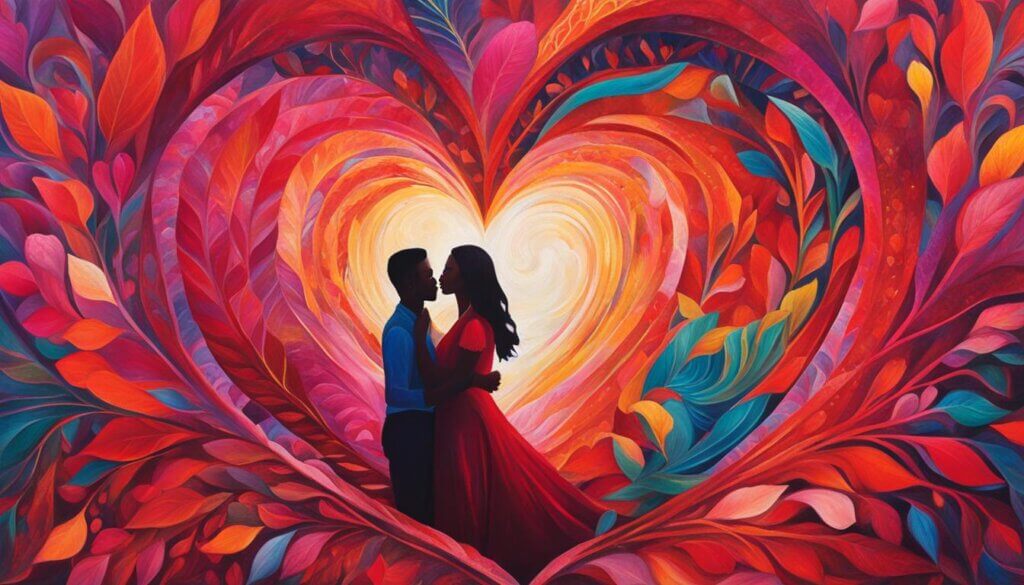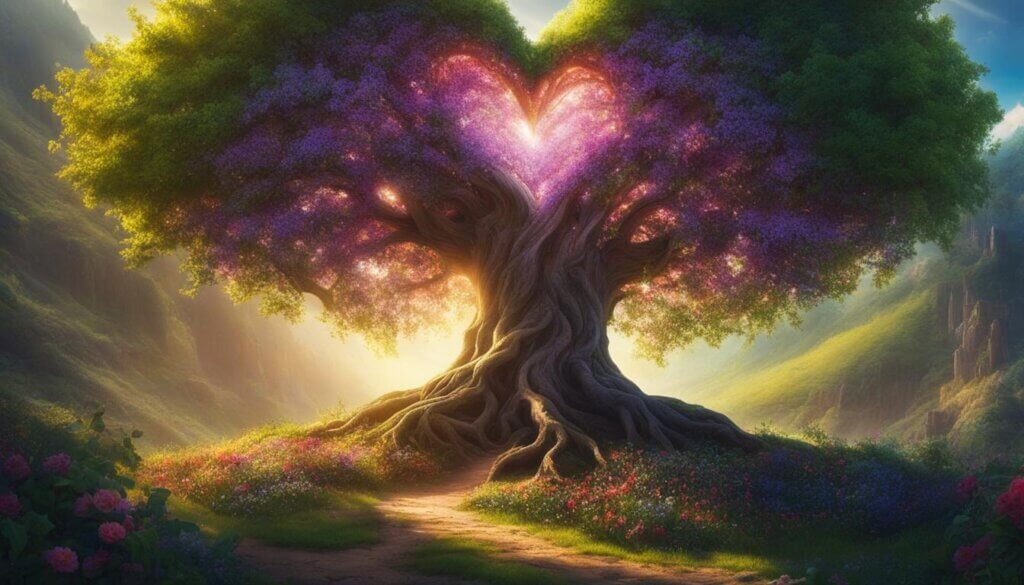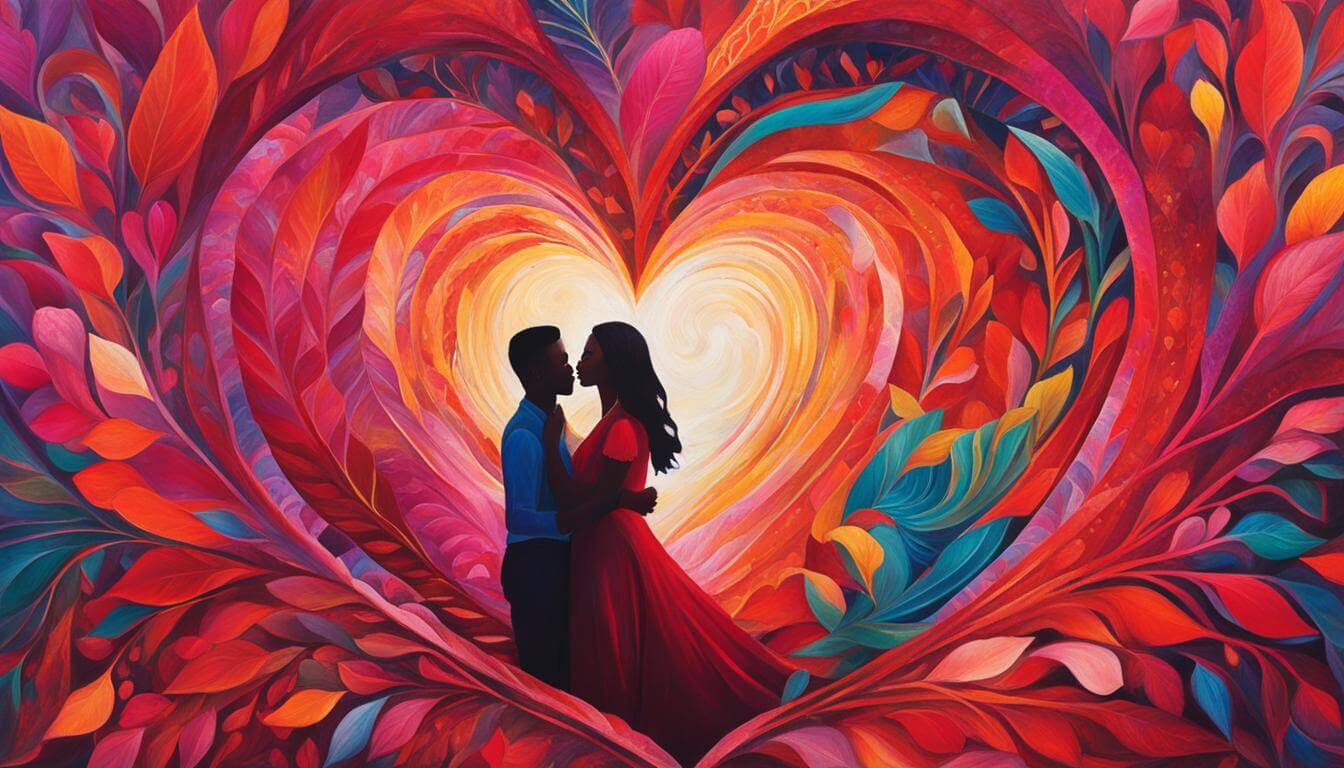Valentine’s Day is a day that celebrates love, but it also has a deeper spiritual meaning. This day is observed on February 14th every year and has roots in ancient Roman times. While many people celebrate with gifts and gestures of love, there is a spiritual aspect to Valentine’s Day that transcends romantic love. It is an opportunity to connect with divine love and cultivate a heart-centered celebration. By understanding and embodying the spiritual meaning of Valentine’s Day, we can deepen our understanding of love as a spiritual practice and honor the sacred bonds of love that connect us all.
Key Takeaways:
- Valentine’s Day has a deep historical background and originated from ancient Rome.
- It holds spiritual significance and is a day to honor and tap into the universal energy of love.
- Incorporating spirituality into Valentine’s Day celebrations can enhance the experience and deepen connections.
- Valentine’s Day is filled with symbolism and traditions associated with love and romance.
- Love can be celebrated in different ways on Valentine’s Day, from romantic getaways to expressing through art and creativity.

A heart-shaped tree with roots deep in the ground, surrounded by vibrant flowers and blooming vines. A beam of light shining down on the tree, illuminating it and highlighting its spiritual significance.
The Historical Origins of Valentine’s Day
Valentine’s Day has a fascinating history that can be traced back to ancient Rome. While the exact origins of this holiday are not clear, there are several theories that provide insights into its historical roots. One theory suggests that Valentine’s Day originated from a Roman festival called Lupercalia, which was celebrated in mid-February to honor the god Lupercus and promote fertility.
During Lupercalia, young men would draw names of eligible women from a jar, and they would be paired as couples for the duration of the festival. This practice was believed to bring fertility and ensure a successful harvest. Another theory links Valentine’s Day to the martyrdom of Saint Valentine, a priest who lived in Rome during the reign of Emperor Claudius II in the third century.
Despite the uncertainties surrounding its origins, Valentine’s Day gradually evolved and gained popularity over the centuries. What once began as a pagan celebration has transformed into a day of love and affection, symbolized by the exchange of cards, gifts, and gestures of romance. Today, Valentine’s Day is celebrated worldwide and continues to be a time to express love and appreciation for the people who hold a special place in our hearts.
| Historical Origins of Valentine’s Day | Key Points |
|---|---|
| Roman festival Lupercalia | Associated with fertility and pairing of couples |
| Martyrdom of Saint Valentine | Linked to the commemoration of a priest during the reign of Emperor Claudius II |
| Evolving celebration | Transformed into a day of love and affection with the exchange of cards and gifts |
The Spiritual Significance of Valentine’s Day
Beyond its historical origins, Valentine’s Day holds spiritual significance. It is a day to honor and tap into the universal energy of love. This day serves as a reminder to cultivate love in all aspects of life and see love as a transformative force that can lead to inner growth and spiritual evolution.
By embracing the spiritual symbolism of Valentine’s Day, we can deepen our connection with the divine and experience a sense of divine union within ourselves and with others.
Love is a powerful force that transcends boundaries and brings people together. It has the ability to heal, inspire, and create profound inner transformation. On Valentine’s Day, we have the opportunity to harness this universal energy of love and direct it towards ourselves, our loved ones, and the world.
Love is not just a fleeting emotion or a romantic gesture; it is a fundamental aspect of our existence. It has the power to awaken our true essence and bring us into alignment with our higher selves.
By embracing the spiritual significance of Valentine’s Day, we can open our hearts to the transformative power of love and experience the profound joy and fulfillment that comes from connecting with the divine within ourselves and in our relationships.
Incorporating Spirituality into Valentine’s Day Celebrations
Valentine’s Day is not just about romantic love; it is also an opportunity to cultivate a deeper spiritual connection with yourself and your loved ones. By incorporating spirituality into your Valentine’s Day celebrations, you can create a heart-centered experience that goes beyond traditional gestures of affection. Here are some ways to infuse spirituality into your Valentine’s Day:
1. Heart-Centered Connection
Instead of focusing solely on material gifts, prioritize genuine connection and emotional intimacy. Take the time to express your love, compassion, and gratitude towards your partner, friends, and family. Engage in meaningful conversations that deepen your bond and strengthen your relationships. Remember, it is the quality of connection that matters most.
2. Cultivating Unconditional Love
Let go of expectations and judgments, and embrace the practice of unconditional love. This means accepting your loved ones as they are, flaws and all, and offering them love and support without conditions. Practice empathy, forgiveness, and compassion, both towards yourself and others. By cultivating unconditional love, you create a safe and nurturing space for growth and connection.
3. Spiritual Rituals
Enhance the spiritual experience of Valentine’s Day by incorporating rituals that hold personal significance for you and your loved ones. This can include meditation, prayer, or creating a sacred space in your home where you can come together and connect on a deeper level. Engage in activities that uplift your spirit and align with your spiritual beliefs.
4. Mindfulness and Presence
Practice mindfulness and presence throughout the day, allowing yourself to fully experience each moment with your loved ones. Put away distractions and be fully present during conversations, meals, and shared activities. By being present, you deepen your connection and create lasting memories that are rooted in love and shared experiences.

A couple sitting across each other, surrounded by hearts, holding hands with their eyes closed and radiating a warm golden light. The hearts are entwined and pulsing with energy, symbolizing a heart-centered connection that transcends physical boundaries. The background is a soft purple hue, representing the spiritual energy of love and compassion.
By incorporating spirituality into your Valentine’s Day celebrations, you can create a meaningful and transformative experience for yourself and your loved ones. Remember, love is not just a feeling; it is a powerful force that can bring healing, growth, and connection. Embrace the spiritual aspects of Valentine’s Day and let it be a reminder of the profound love that exists within and around you.
The Symbolism and Traditions of Valentine’s Day
Valentine’s Day is filled with symbolism and traditions that have become synonymous with love and romance. These symbols and traditions add depth and meaning to this special day, making it a time to express affection and celebrate the bonds of love. Let’s explore some of the most well-known symbols and traditions associated with Valentine’s Day.
Love Symbols
Two of the most recognizable love symbols associated with Valentine’s Day are Cupid and the heart shape. Cupid, the mischievous god of love in Roman mythology, is often depicted as a cherubic figure with a bow and arrow. The arrows represent the power of love to ignite passion and create deep connections between individuals. The heart shape, on the other hand, is universally recognized as a symbol of love and affection. It represents the emotional and spiritual center of love, and it is seen everywhere on Valentine’s Day.
Romantic Gestures
Valentine’s Day is a time for romantic gestures that show love and appreciation for our partners. Traditional romantic gestures include exchanging cards, chocolates, flowers, and gifts. These gestures are a way of expressing affection and letting our loved ones know that they are cherished and valued. Whether it’s a handwritten love note, a bouquet of roses, or a thoughtful gift, these gestures communicate love and create meaningful connections.
“Love is not just about receiving, but also about giving. It’s about showing someone that they matter and that they are loved.”
Table: Valentine’s Day Symbols and Traditions
| Symbol/Tradition | Meaning |
|---|---|
| Cupid | The god of love who represents the power of love to ignite passion. |
| Heart shape | A symbol of love and affection, representing the emotional and spiritual center of love. |
| Exchanging cards | A way to express affection and appreciation for loved ones. |
| Chocolates | A sweet treat symbolizing indulgence and pleasure, often given as a token of affection. |
| Flowers | Bouquets of roses, particularly red roses, are a classic symbol of love and beauty. |
| Gifts | Thoughtful presents that show love and appreciation for one’s partner. |
Valentine’s Day is a time to celebrate love and meaningful connections. The symbols and traditions associated with this special day add depth and romance to our expressions of affection. Whether it’s through the iconic love symbols of Cupid and the heart shape or the romantic gestures of exchanging cards, chocolates, and gifts, Valentine’s Day provides an opportunity to honor and cherish the love we share with our partners.
Remember, love is not just about receiving, but also about giving. It’s about showing someone that they matter and that they are loved. So, let your heart guide you as you celebrate this special day and create beautiful memories with your loved ones.
Celebrating Love in Different Ways on Valentine’s Day
Valentine’s Day is a wonderful opportunity to express love and celebrate the special people in your life. While traditional gifts like chocolates and flowers are always appreciated, there are many unique and creative ways to show your love. Here are some gift ideas, romantic getaways, handwritten notes, and ways to express love through art and creativity that will make this Valentine’s Day truly memorable.
Gift Ideas
When choosing a gift for your loved one, think about their interests and passions. Consider personalized gifts, such as a custom piece of jewelry or a photo album filled with cherished memories. You could also plan a surprise date night, complete with tickets to a concert or a reservation at their favorite restaurant. Remember, it’s the thought and effort you put into the gift that truly matters.
Romantic Getaways
Escape the everyday routine and create lasting memories with a romantic getaway. Whether it’s a cozy cabin in the mountains or a luxurious beach resort, spending quality time together in a new and romantic setting can reignite the spark in your relationship. Take the time to disconnect from the outside world and focus on each other, enjoying intimate moments and creating a deeper connection.
Handwritten Notes
There is something incredibly meaningful about a handwritten note or letter. It allows you to express your feelings in a personal and heartfelt way. Take the time to write a love letter to your partner, telling them what they mean to you and how they have impacted your life. Leave little love notes throughout the day, reminding them of your affection. These simple gestures can make a big difference and show your loved one just how much they are cherished.
Expression Through Art and Creativity
Get in touch with your artistic side and use creativity as a way to express your love. Paint a picture, compose a song, or write a heartfelt poem. Use your talents to create something unique and personal for your partner. You could also plan a fun and creative activity together, such as a pottery class or a cooking workshop. Embracing art and creativity can add an extra touch of love and thoughtfulness to your Valentine’s Day celebration.

Create an artwork that captures the essence of love as a spiritual force transcending all barriers of language, culture, and religion. Use vibrant colors, bold strokes, and intricate patterns to convey the infinite potential for human connection and the joyous celebration of life on Valentine’s Day. Show how love can be expressed through art and creativity, inspiring us to reach out to others with kindness, compassion, and generosity of spirit.
Use symbols like hearts, flowers, and birds to represent the beauty and harmony of the natural world, and incorporate elements of nature to evoke a sense of peace and serenity. Let your imagination soar as you unleash your inner artist and explore the limitless possibilities of love as an expression of the divine.
Remember, Valentine’s Day is about celebrating love in all its forms. Whether you choose a traditional gift or opt for a more unique and unconventional approach, the most important thing is to show your love and appreciation for the special people in your life. With a little thought and creativity, this Valentine’s Day can be a truly memorable and meaningful celebration of love.
The Cultural and Global Celebration of Valentine’s Day
Valentine’s Day is a celebration that is observed in many countries around the world, albeit with cultural differences. While it is widely celebrated in Western countries, some countries have resistance or even prohibit the celebration of Valentine’s Day due to religious or cultural reasons. Understanding the cultural and global aspects of Valentine’s Day can provide insight into the diverse ways in which love is celebrated and perceived.
In Western countries, Valentine’s Day is often associated with romantic love and is celebrated by exchanging gifts, cards, and gestures of affection. It is a day dedicated to expressing love and appreciation for romantic partners, friends, and family members. The traditions and symbols of Cupid and the heart shape are deeply ingrained in the Western cultural celebration of Valentine’s Day.
However, in countries like Indonesia, Saudi Arabia, and Malaysia, there is resistance or prohibition towards celebrating Valentine’s Day. This is often due to religious concerns or cultural beliefs that view the holiday as a Western import that goes against traditional values. In some cases, alternative celebrations or customs may be observed on different dates that promote love and affection within the cultural context.
| Country | Celebration |
|---|---|
| United States | Exchanging gifts, cards, and romantic gestures |
| France | Exchanging love letters and romantic dinners |
| South Korea | Women give chocolates to men on February 14th, men reciprocate on March 14th |
| India | Increasing popularity of celebrating love with gifts and romantic outings |
Despite cultural differences and resistance, the celebration of Valentine’s Day continues to gain global popularity. The underlying message of love and the desire to express affection transcends cultural boundaries. It serves as a reminder of the universal nature of love and its power to connect people across different cultures and traditions.
Celebration of Love Around the World:
- In Japan, Valentine’s Day is a day for women to give chocolates to men, with different types of chocolates symbolizing different levels of affection.
- In Brazil, Valentine’s Day is celebrated on June 12th and is known as “Dia dos Namorados,” which translates to “Lovers’ Day.” It is a day to celebrate love with romantic dinners and exchanging gifts.
- In South Africa, Valentine’s Day is celebrated with a unique twist known as “Lupercalia.” People wear the color of their heart’s desire and write the name of their loved one on their sleeves, quite literally.
The cultural and global celebration of Valentine’s Day showcases the diverse ways in which love is expressed and celebrated around the world. While there are variations in traditions and customs, the underlying sentiment of love remains constant, reminding us of the universal power of love to bring people together.
The Ever-Evolving Nature of Valentine’s Day
Valentine’s Day, like any other holiday, is not immune to change. Each year, this special day brings with it a new theme or focus, adding a fresh perspective to the celebration. These changing themes have become an integral part of the Valentine’s Day experience, allowing us to explore different aspects of love and connection. By embracing and adapting to these annual themes, we can infuse our celebrations with renewed meaning and intention.
The numerological symbolism of Valentine’s Day also adds an intriguing layer to the ever-evolving nature of this holiday. Falling on February 14th, the date itself holds its own significance. The number 14 is associated with qualities such as harmony, love, and balance. It represents the union of two individuals, making it the perfect date for a celebration centered around love. Understanding and embracing this numerological symbolism can deepen our connection with the energy of Valentine’s Day.
As Valentine’s Day continues to evolve, it encourages us to reflect on our relationships and explore new approaches to love and connection. Whether it’s through exploring different traditions, incorporating mindfulness into our celebrations, or finding unique ways to express our love, the ever-evolving nature of Valentine’s Day invites us to embrace growth and change in our relationships. By aligning ourselves with the current energies and themes of this special day, we can create meaningful and memorable experiences that honor the power of love.
Conclusion
The spiritual meaning of Valentine’s Day goes far beyond just romantic love. It reminds us of the transformative power that love holds in all aspects of our lives. By embracing the spiritual significance of this day, we can deepen our connection with the divine and experience inner transformation through love.
Valentine’s Day serves as a beautiful reminder to cultivate love, compassion, and gratitude in our lives. It is an opportunity to honor the sacred bonds of love that connect us all. As we celebrate this day, let us remember the universal energy of love and the divine union that exists within each and every one of us.
Love is a transformative force that has the ability to shape and change us. It has the power to heal, inspire, and bring joy to our lives. As we celebrate Valentine’s Day, let us recognize and embrace the depth and beauty of love in all its forms. May this day be a reminder that love is not limited to one day, but is a practice that we can cultivate every day of our lives.
FAQ
What is the spiritual meaning of Valentine’s Day?
Valentine’s Day is a day to honor and connect with the universal energy of love. It is an opportunity to cultivate love as a spiritual practice and deepen our understanding of love as a transformative force.
What are the historical origins of Valentine’s Day?
The exact origins of Valentine’s Day are unclear, but it is believed to have roots in ancient Roman times. One theory suggests it originated from the Roman festival called Lupercalia, while another theory links it to the martyrdom of a priest named Valentine during the reign of Emperor Claudius II.
How can I incorporate spirituality into my Valentine’s Day celebrations?
You can focus on heart-centered connection by expressing love, compassion, and gratitude towards others. Engaging in spiritual rituals such as meditation, prayer, or creating sacred space can also enhance the spiritual experience of Valentine’s Day.
What are some popular symbols and traditions associated with Valentine’s Day?
Cupid, the god of love, and the heart symbol are widely associated with Valentine’s Day. Romantic gestures such as exchanging cards, chocolates, flowers, and gifts have become customary ways to express love and affection on this day.
How can I celebrate love in different ways on Valentine’s Day?
There are endless ways to celebrate love on Valentine’s Day. Some ideas include giving chocolates, jewelry, or shared his and hers items as gifts. Planning a romantic getaway or expressing love through art and creativity are also heartfelt ways to celebrate love.
How is Valentine’s Day celebrated globally?
While Valentine’s Day is widely celebrated in Western countries, some countries resist or prohibit the celebration due to religious or cultural reasons. However, the popularity of Valentine’s Day continues to grow globally, symbolizing the universal nature of love.
How does Valentine’s Day evolve each year?
Each year brings a new theme or focus to the celebration of Valentine’s Day. Numerological symbolism associated with the date of February 14th adds additional layers of meaning and energy.
What is the spiritual significance of Valentine’s Day?
Valentine’s Day holds spiritual significance as a day to honor and tap into the universal energy of love. It serves as a reminder to cultivate love, compassion, and gratitude in all aspects of life and honor the sacred bonds of love that connect us all.
